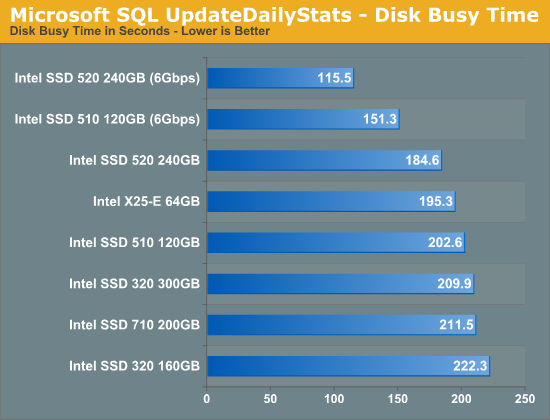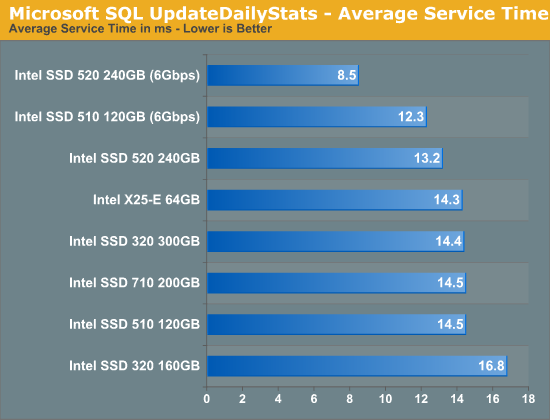A Look at Enterprise Performance of Intel SSDs
by Anand Lal Shimpi on February 8, 2012 6:36 PM EST- Posted in
- Storage
- IT Computing
- SSDs
- Intel
Enterprise Storage Bench - Microsoft SQL UpdateDailyStats
Our next two tests are taken from our own internal infrastructure. We do a lot of statistics tracking at AnandTech - we record traffic data to all articles as well as aggregate traffic for the entire site (including forums) on a daily basis. We also keep track of a running total of traffic for the month. Our first benchmark is a trace of the MS SQL process that does all of the daily and monthly stats processing for the site. We run this process once a day as it puts a fairly high load on our DB server. Then again, we don't have a beefy SSD array in there yet :)
The UpdateDailyStats procedure is mostly reads (3:1 ratio of GB reads to writes) with 431K read operations and 179K write ops. Average queue depth is 4.2 and only 34% of all IOs are issued at a queue depth of 1. The transfer size breakdown is as follows:
| AnandTech Enterprise Storage Bench MS SQL UpdateDaily Stats IO Breakdown | ||||
| IO Size | % of Total | |||
| 8KB | 21% | |||
| 64KB | 35% | |||
| 128KB | 35% | |||

Our SQL tests are much more dependent on sequential throughput and thus we really see some impressive gains from moving to a 6Gbps SATA interface. Among the 3Gbps results the Intel SSD 520 is now the top performer, followed once again by the X25-E. To be honest, most of these drives do perform the same as they bump into the limits of 3Gbps SATA.


Once again we see a huge reduction in service time from the Intel SSD 520 running on a 6Gbps interface. Even on a 3Gbps interface the 520 takes the lead while the bulk of the 3Gbps drives cluster together around 14.4ms. Note the tangible difference in performance between the 300GB and 160GB Intel SSD 320. The gap isn't purely because of additional NAND parallelism, the 300GB drive ends up with more effective spare area since the workload size doesn't scale up with drive capacity. What you're looking at here is the impact of spare area on performance.










55 Comments
View All Comments
krazyderek - Thursday, February 9, 2012 - link
i've been thinking about recycling some agility 2's into a raid array on a server, and this article gives a great blue print on the intel side of things! thank you!neotiger - Thursday, February 9, 2012 - link
It's important to note that most of the SSDs you tested are not suitable for "enterprise" use because they are not crash-safe.X25-E, 510, 520 - none of them come with capacitors. That means in the event of a crash or power outage your data will be lost or corrupted (most likely both). They are not suited for enterprise use.
Per Hansson - Sunday, February 12, 2012 - link
Hi Anand,Any interest in testing Adaptecs Hybrid RAID?
It claims to offer good speed on a RAID-1 setup with a normal HDD together with a SSD.
Something that on a normal controller would limit the SSD to the write speed of the HDD...
http://ask.adaptec.com/scripts/adaptec_tic.cfg/php...
Also will you be including any more SLC drives in your tests?
Like the Micron RealSSD P300
http://www.micron.com/products/solid-state-storage...
I love that you are finally starting to do enterprise tests :)
Regards,
Per Hansson
silversurferer - Saturday, February 18, 2012 - link
Hi,Fabulous article - very well written!
Just digging in on SSD since im having huge problem with my mailserver as the accounts and files grow in numbers and weight.
It seems that SSD is made for this, if im not mistaking. Witch SSD disk would be suited for this and what kind of setup is recommended? Take gladely any pointers in this subject.
Thx.
enealDC - Monday, February 20, 2012 - link
Don't normally post, but I wanted to say great read!